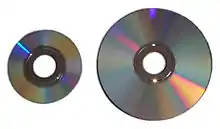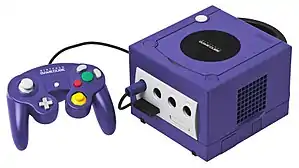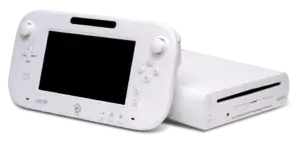Nintendo optical discs
Nintendo optical discs are physical media used to distribute video games on three of Nintendo's consoles that followed the Nintendo 64. These are the GameCube Game Disc, Wii Optical Disc, and Wii U Optical Disc. The physical size of a GameCube Game Disc is that of a miniDVD; the Wii and Wii U Optical Discs are the size of a DVD, a CD, and a Blu-ray. To maintain backward compatibility between generations of game consoles, GameCube discs are compatible with the first model of the Wii, and Wii Optical Discs are compatible with the Wii U. A burst cutting area is located at the inner ring of the disc surface.
 | |
| Media type | Read-only optical disc |
|---|---|
| Encoding | Digital |
| Capacity |
|
| Read mechanism | Laser |
| Developed by | Nintendo Panasonic |
| Dimensions |
|
| Usage | |
In 2017, Nintendo discontinued disc-based media in favor of game cards for the Wii U's successor, the Switch.
Format
| Optical discs |
|---|

GameCube Game Disc
The GameCube Game Disc (DOL-006) is the game medium for the GameCube, created by Matsushita/Panasonic,[1][2][3][4] and later extended for use in the backward compatibility mode of the first model of Wii.[5] The GameCube is Nintendo's first optical disc console, after mainly ROM cartridge based platforms. The GameCube Game Disc is a 1.46 GB,[6] 8 cm miniDVD-based[7] technology which reads at a constant angular velocity (CAV).[8] It was chosen by Nintendo to prevent copyright infringement of its games,[4][9][3] to reduce manufacturing costs compared to Nintendo 64 Game Paks,[1][4][10] and to avoid licensing fees to the DVD Forum.[1][4] GameCube Game Discs do not use the Content Scramble System found on normal DVD-Video discs, as Nintendo was not satisfied with its level of security.[3]
The GameCube is not able to be used as a general DVD player, except for the Panasonic Q which is a uniquely customized GameCube with DVD capability that was released only in Japan.[4][11]
Some GameCube games with large amounts of data span two discs, such as Resident Evil 4, Enter the Matrix, and Tales of Symphonia. Some multi-platform games that fit on single discs for PlayStation 2 and Xbox had certain features removed in order to fit on GameCube Game Discs. Full-motion video (FMV) scenes and audio clips have higher compression or lower quality to fit on a single disc.
Wii Optical Disc
The Wii Optical Disc (RVL-006) is the physical game medium for the Wii, created by Panasonic. Nintendo extended its proprietary technology to use a full size 12 cm, 4.7/8.54 GB DVD-based[12] disc, retaining the benefits of the GameCube Game Disc, and adding the standard capacity of a double-layer DVD-ROM. Wii Discs can include updates to the Wii system software, which are installed before starting the game, ensuring that systems not connected to the internet are still updated.[13] For the same reasons as GameCube and Wii U, Wii cannot play DVD movies or CDs.
The Wii can use double-layer discs, and all games are single-layer prior to the release of Super Smash Bros. Brawl.[14][15] Upon that release, Nintendo admitted that some Wii systems may have trouble reading dual-layer discs due to a dirty laser lens.[15][16] Nintendo repaired systems with dual-layer problems,[15][17] and later released a disc cleaning kit for users to purchase.[18]
Wii U Optical Disc
The Wii U Optical Disc (WUP-006) is the retail physical game medium for the Wii U, with a capacity of 25 GB. The Wii U system software is backward compatible with Wii Optical Discs, but not with GameCube game discs.[19] The Wii U Optical Discs differ in appearance from most other optical discs in that they have soft, rounded edges.[20]
The console's optical drive was developed and supplied by Panasonic,[21] a founding member in the Blu-ray Disc Association.[22] It is not clear whether the Wii U Optical Disc is similar in physical design to the Blu-ray physical disc specification. Nintendo president Satoru Iwata stated, "Wii U does not have DVD or Blu-ray playback capabilities. The reason for that is that we feel that enough people already have devices that are capable of playing DVDs and Blu-ray, such that it didn't warrant the cost involved to build that functionality into the Wii U console because of the patents related to those technologies". Like with the GameCube and Wii optical discs, it was chosen by Nintendo to prevent copyright infringement of games, to reduce cost by avoiding licensing fees to the Blu-ray Disc Association (BDA), and to reduce loading times. This also prevents the console from being modified into a DVD or Blu-ray movie player.[23][24]
Burst cutting area
Each Nintendo optical disc contains a burst cutting area (BCA) mark, a type of barcode that is written to the disc with a YAG laser. The data stored in this BCA mark includes an encrypted table related to the hardware-based copy-protection mechanics, in addition to 64 bytes of un-encrypted user-accessible data.[25]
A BCA mark is visible to the naked eye. It is different than the IFPI mark that is on all optical discs. BCA is described in Annex K of the physical specification, and can be seen between radius 22.3±0.4 mm and 23.5±0.5 mm. There are also six additional evenly spaced small cuts, visible with a strong light source, located just outside the BCA radius, which are related to the copy-protection.[25] Their value as a copy protection mechanism diminished after Datel discovered that the same pattern could be recorded into the DVD instead of needing to be precisely cut later.[26]
See also
References
- "GameCube FAQ - DVD". Nintendo World Report. March 7, 2001. Archived from the original on June 18, 2020. Retrieved July 6, 2011.
- "GameCube FAQ - Matsushita". Nintendo World Report. June 20, 2001. Archived from the original on June 18, 2020.
- Hara, Yoshiko (May 12, 1999). "Matsushita allies with Nintendo on next-generation game console". EE Times. Archived from the original on June 18, 2020.
- "The Ultimate Gamecube FAQ". IGN. July 10, 2001. Archived from the original on June 18, 2020.
- Casamassina, Matt (September 12, 2006). "IGNcube's Nintendo "Revolution" FAQ". IGN. Archived from the original on January 21, 2012. Retrieved September 7, 2006.
- "Nintendo GameCube Special Edition". Avrev.com. June 1, 2003. Archived from the original on October 27, 2011. Retrieved July 6, 2011.
- Jones, Steven E.; Thiruvathukal, George K. ""Power Isn't Everything": The Wii Console". Codename Revolution: The Nintendo Wii Platform. Platform Studies. MIT Press. p. 29. ISBN 978-0-262-01680-3.
- Shimpi, Anand Lal (December 7, 2001). "DVD, but not - Hardware Behind the Consoles - Part II: Nintendo's GameCube". AnandTech. Archived from the original on July 15, 2020.
- "Beginner's Guide: GameCube". GameSpy. July 30, 2003. Archived from the original on June 17, 2020. Retrieved September 7, 2006.
- Pian, Sharon (November 11, 2001). "Let the games begin: The 3-way race is on". Business & Technology. The Seattle Times. Archived from the original on June 18, 2020. Retrieved July 6, 2011.
- "Play it again". Smh.com.au. September 13, 2003. Archived from the original on November 8, 2012. Retrieved July 6, 2011.
- Jones, Steven E.; Thiruvathukal, George K. "Introduction: Starting with Revolution: The Wii as a Platform". Codename Revolution: The Nintendo Wii Platform. Platform Studies. MIT Press. p. 12. ISBN 978-0-262-01680-3.
So it's possible, for example, to turn on the Wii, access different channels (including the Disc Channel to the optical drive for running games on DVD-ROMs), and play multiple generations of Mario games...
- Jones, Steven E.; Thiruvathukal, George K. "Channeling the System: Access, Distribution, and Transmission". Codename Revolution: The Nintendo Wii Platform. Platform Studies. MIT Press. p. 100. ISBN 978-0-262-01680-3.
- "Review – Super Smash Bros. Brawl". SlashGear. Archived from the original on June 18, 2020. Retrieved July 6, 2011.
- "Tobacco smoke makes Super Smash Bros Brawl unplayable on Wii". TG Daily. February 6, 2008. Archived from the original on June 18, 2020. Retrieved July 6, 2011.
- Colbourne, Scott (March 20, 2008). "Not just a smash, a Super Smash". Toronto: The Globe and Mail. Archived from the original on June 18, 2020. Retrieved July 6, 2011.
- Nintendo of America. "Repair Form for U.S. Residents". Nintendo of America. Archived from the original on March 10, 2008. Retrieved March 9, 2008.
- "Wii Lens Cleaning Kit Overview". Nintendo of America. Archived from the original on June 18, 2020.
- Klepek, Patrick (June 8, 2011). "Wii U Does Not Play GameCube Games". Giant Bomb. Archived from the original on June 18, 2020. Retrieved July 6, 2011.
- Gilbert, Ben (November 12, 2012). "Take a very, very close look at the round-edged Wii U proprietary discs". Engadget. Archived from the original on November 13, 2012. Retrieved November 18, 2012.
- Leadbetter, Richard (November 22, 2012). "Nintendo Wii U review". Eurogamer. Archived from the original on July 18, 2020.
- "Disclosure of Specifications for Large Capacity Optical Disc Recording Format Utilizing Blue-Violet Laser Blu-ray Disc Begins". Sony. May 20, 2002. Archived from the original on July 18, 2020.
- "2011 E3 Expo Analyst Q & A Session". Nintendo. June 8, 2011. Q8. Archived from the original on June 17, 2020. Retrieved July 1, 2014.
- "Wii U will not feature DVD playback - Everybody Plays - Nintendo Wii". Everybody Plays. Everybody Plays. Archived from the original on February 11, 2015. Retrieved July 6, 2011.
- Felix “tmbinc” Domke (November 7, 2008). "Anatomy of an Optical Medium Authentication (Part 1)". Archived from the original on June 18, 2020. Retrieved May 21, 2013.
- Benchoff, Brian (February 4, 2019). "How One Company Cracked The Gamecube Disc Protection". hackaday. Archived from the original on June 18, 2020. Retrieved May 16, 2019.
External links
| Wikimedia Commons has media related to Nintendo optical discs. |



